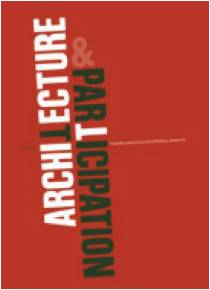“Architectural participation is the involvement of the user at some stage in the design process. “
Participation becomes an organized and potentially manipulated part of any project, in which users are meant to be given a voice, but the process usually stifles these voices.
The book identifies certain reasons for the non-credibility of architecture: The period of the heroes, of the born-again, of the universal solutions is over. Function no longer automatically generates form, less has ceased to be more i.E., Utility and beauty are no longer two halves of the same apples. But the effort to unite research and action in a coherent whole is also over. In the pathos of an improbable social position, there is much self-negation. But usually those who negate themselves in public work for property speculation in private, so earning the means to negate themselves without losing their peace of mind. In architecture’s ideological sphere, therefore, there is much confusion.
There is just as much confusion in its practical sphere, where planning is as empirical, inspired, intuitive and makeshift as ever, and construction remains as crude, imprecise and inefficient as it was in the roman times. Since it has not been possible to deal with the quality-quantity dilemma, the whole problem of planning for the great number has been eluded, simply by slipping into monumentalism or formal utopia, with a great production of hypotheses for mausolea, mega structures, universal systems, futurables, etc, designed mostly for art galleries or current events magazines.
In the meantime, problems of territorial organization –of human reorganization, transport, housing, facilities, the workspaces –remain unsolved. There is still criticism, and as a vehicle for propaganda the journalism of reviews and weekly magazines. Overfed by the crisis of ideas and action, criticism travels a tangled network of roads. But this also leads to certain repercussions. The first analyses architecture through the behavior of its heroes, and, if lacking heroes, tends to invent them, causing misunderstandings that are troublesome to demythologize. The second creates sudden unnecessary changes in the habits of the architect. It brings about a transformation of the language of architecture.
The decisive function of journalism in diverting architecture from its real context is well-known. There is hardly a magazine or newspaper column that illustrates architecture taking the user into account; that furnishes news about how architecture really functions in its daily existence; that publishes images, photographs or articles in which the people who use, transform and recompose architecture are actually present. It is as if architecture were merely a potential space and not an actual place, concrete, made of real materials, and inhabited by people in a permanent and continually changing relationship.
While human activities multiply, becoming diversified, decisions about where and how they should take place are increasingly concentrated in the spheres of economic, bureaucratic and technological power. The role of architecture could be to contribute to the freezing or thawing of this paradox, according to the stand it decides to take –on the side of the power structure, or on the side of those overwhelmed and excluded by it. While it is certain that only the second choice can allow a concrete renewal, it is also certain that this choice can never be made by architecture.
In reality, architecture has become too important to be left to architects. It is necessary to develop new characteristics in the practice of architecture and new behavior pattern in its authors. Therefore all barriers between builders and users must be abolished, so that building and using become two different parts of the same planning process. Therefore, the intrinsic commitment of architecture and the forced passivity of the user is fused to create a condition of creative and decisive equality where each -with a different impact –is the architect, and every architectural event –regardless of who conceives it and carries it out –is considered architecture.
For some, the potential renaissance of planning, in the face of public indifference and distrust and in a climate where the planning system is often characterized as a barrier to development, is to be found in the current turn towards participation. Everywhere planners are being exhorted to engage actively with communities and stakeholders in the planning of urban and rural areas, at scales ranging from regions to cities, neighbourhoods and villages.
Participation is now at the heart of plan-making and strategy development, as well as being an inseparable element of individual planning decisions. But if planning with participation is to restore trust in public decision-making, then certain questions arise about the new practices of participation:
Are we really seeking the emergence of a new paradigm of participatory planning, where resolving differences of interest over the uses of space, and seeking consensus in the making of places become participative activities Or is public participation just something that planners have to do, part of an increasingly audited system where planners need to show how they have established community support for their plans.
Public participation in planning is by no means a new thing. The planning system has had to engage with the public for many years, and in consequence planners and planning academics have been led to explore these issues both theoretically and practically. Similar issues arise in related fields: wherever architects and other built environment professionals come to engage more with the public they will encounter parallel debates and face the same ethical and political challenges.
This book review was written by: Anshumali Baruah


Leave a Reply
You must be logged in to post a comment.